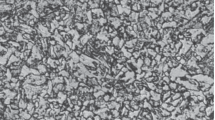Conclusions
-
1.
The susceptibility to temper brittleness of steel 30Kh2N2SMK5 (EP 822) was determined by means of primary and secondary tempering and from the shift of the ductile-brittle transition temperature.
-
2.
It was found that forgings 315 mm in diameter are susceptible to reversible temper brittleness. The difference between the ductile-brittle transition temperature after quenching + tempering and after maximum embrittlement is around 200°.
The maximum embrittlement temperature is 500–525° for steel 30Kh2N2SMK5, and the range of reversible temper brittleness is 400–610°.
Similar content being viewed by others
Literature cited
L. M. Utevskii, Temper Brittleness of Steel [in Russian], Metallurgizdat, Moscow (1961).
A. V. Taran, “Determining susceptibility to reversible temper brittleness,” Metal. i Term. Obrabotka Metal., 10, 35 (1973).
E. Houdremont, Special Steels [Russian translation], Vol. 1, Metallurgiya, Moscow (1966), p. 329.
Additional information
All-Union Scientific-Research Institute of Electromechanics. I. P. Bardin Central Scientific-Research Institute of Ferrous Metallurgy. Translated from Metallovedenie i Termicheskaya Obrabotka Metallov, No. 8, pp. 26–29, August, 1975.
Rights and permissions
About this article
Cite this article
Nikitin, P.N., Murav'eva, E.M., Rudnev, N.F. et al. Temper brittleness of forged steel 30Kh2N2SMK5. Met Sci Heat Treat 17, 666–668 (1975). https://doi.org/10.1007/BF00664313
Issue Date:
DOI: https://doi.org/10.1007/BF00664313




